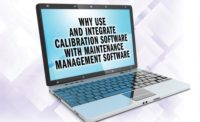
Historically, when considering calibration software, it is the administrative features of the software that first come to mind. In other words, receiving the equipment and tracking it through the laboratory. These are handy features considering that some factories have thousands of tools that need to be calibrated, but sometimes it is not enough.
What these software packages do not do is the calibration itself. The MudCats Calibration Process Manager, from Edison ESI (Westminster, CA), is a software tool that tackles the challenges of the calibration process head-on, including the need to account for measurement uncertainty, says Ken Racen, business development manager, metrology and inspection services, at Edison ESI.
“What this software does is manage the actual calibration process itself, at the bench, in the field and engineering,” he continues.
That is no small feat. Stringent quality requirements of ISO/IEC-17025 call for the calculation and documentation of estimated measurement uncertainty (EMU). The only way to do that has been manually—a laborious and costly process that required metrologists to determine the uncertainty budget through a complex set of mathematical algorithms. “It’s a very tedious task,” Racen says.
MudCats offers the metrology community a method of complying with ISO/ IEC-17025. It can automatically calculate the EMU, and Test Accuracy Ratio (TAR), by bringing together the information needed to perform the analysis such as equipment specifications, measurement data and statistical quantities on a test-point by test-point basis.
MudCats automatically calculates each test point’s TAR and EMU when a calibration standard is assigned to the datasheet. Using the system’s SpecTrack specification library, MudCats interprets Units of Measure and synchronizes the unit under test (UUT) and Standards test parameters, transforming the data to account for what are typically the most prevalent sources of error. Estimates of measurement uncertainty and test accuracy ratio are developed using guidelines from ANSI/NCSL Z540-2-1997, U.S. Guide to the Expression of Uncertainty in Measurement (GUM), Type B methods. “When you’re dealing with a calibration datasheet that has maybe 70 test points in it, MudCats can calculate the EMU and TAR in about two seconds,” Racen estimates.
Equal-opportunity system
The software is an equal-opportunity system. Rather than being designed for a specific type of calibration, it is a generic system for calibration data collection and analysis across multiple disciplines. “It can be used in an electrical laboratory, dimensional laboratory, temperature laboratory or pressure laboratory,” says Racen.The system is designed for 21 CFR Part 11 compliance for electronic records and electronic signatures. The software can track every data point collected, the operator who did the calibration and when it was done. The data can be stored in a centralized database. It has multiple channels, enabling users to do up to eight calibrations simultaneously. “That’s what makes it unique—it covers the whole gamut,” Racen says. “Say a company wants to look at all the calibrations that it performed on a specific type of caliper over the past year or two. The system can bring up all the ‘As Found’ and ‘As Left’ data, and it can look at that data to see if there are any abnormal trends.”
The system also allows users to filter such data. “If a company wants to look at one particular instrument, it can look at it by who performed the calibration or by individual customers,” he adds. “If there is one particular customer that may abuse their equipment, for example, the results would show a lot of ‘As Found’ data that is out of the tolerance band. So you can really analyze that particular information.”
MudCats can also perform calibration interval analysis, looking at the “As Found” and “As Left” data and determining the correct calibration interval, based on historical parametric data and reliability targets. “That’s a huge benefit,” Racen says. “Because up until this point, we’ve only been able to determine calibration intervals based on binary data—was the equipment in tolerance or was it out of tolerance when it was received? This allows you to make calibration interval analysis and adjustments based on actual data and scientific analysis,” including equipment failure analysis, equipment interval analysis, and reverse traceability from independent ranges of the Standard and UUT.
The system eliminates the need for handwritten data reports as well as the task of creating and saving individual MS Word or Excel files. Other calibration tools include integrated automation. Automation commands can be added to any row of a new or pre-existing datasheet without using instrument drivers. A custom tolerance calculator allows users to create a library of custom specifications, combine custom and standard specification components, and test the calculator prior to use. An integrated tolerance calculator allows users to generate single and multiple test point row data by entering nominal test point values and equipment specification data.
The system uses a Microsoft SQL server as the database engine; an Oracle application is in the works, Racen says. The system can run on any standard Pentium-class PC running Windows 98 through XP. Users who want to automate the interface with instruments that can talk to the system will need a General Purpose Interface Bus (GPIB) card.
The Mudcats Calibration Process Manager pricing structure is based upon a database model with add on Client Access Licenses (CAL). The database model that is installed on the customer’s MS SQL Server is $6,990. Client Access Licenses are installed on each workstation at a cost of $1,990. Quantity discounts are available for five or more CAL’s. The Mudcats Datasheet, which consists of 3,000 datasheets, and the Specsheet library, which has more than 500 specsheets, are included.
TECHNOLOGY CONTACT
For more information on MudCats, contact:
Edison ESI
7300 Fenwick Lane
Westminster, CA 92683
(866) 723-2257
www.edisonmudcats.com
QUALITY SPECS
- It automatically calculates the estimated measurement uncertainty, or Type B uncertainty, on a test point by test point basis.
- It is a generic system for calibration data collection and analysis across multiple disciplines.
- Multiple channels allow users to perform up to eight calibrations simultaneously.
